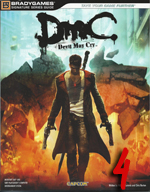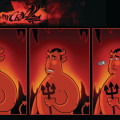 DmC: Devil May Cry can really be summed up with two gaming elements: collectibles and massive boss fights. Okay, so it does have an emphasis on combos, but in terms of strategy guide meat, the combos are nice pieces of fluff that are more for each individual player’s benefit and play style. A strategy guide can’t really help players with combos, since players will prefer certain combos that are unique to each player’s gaming style. For example, I am terrible with executing well-timed combos (there’s a reason why I don’t review fighting games and their strategy guides), so any combos I saw that required a pause in button pressing was immediately ignored. Any combos that were a mash of buttons–particularly mashes of the same button–were instantly added to Dante’s repertoire. The only combos the DmC strategy guide called upon were the combos automatically given when Dante learned a new ability, and selfishly, I was most grateful for that. I might have thrown the strategy guide across the room if it called on me to use a specific combo I needed to purchase–especially because knowing my luck, it would be a combo I couldn’t master.
DmC: Devil May Cry can really be summed up with two gaming elements: collectibles and massive boss fights. Okay, so it does have an emphasis on combos, but in terms of strategy guide meat, the combos are nice pieces of fluff that are more for each individual player’s benefit and play style. A strategy guide can’t really help players with combos, since players will prefer certain combos that are unique to each player’s gaming style. For example, I am terrible with executing well-timed combos (there’s a reason why I don’t review fighting games and their strategy guides), so any combos I saw that required a pause in button pressing was immediately ignored. Any combos that were a mash of buttons–particularly mashes of the same button–were instantly added to Dante’s repertoire. The only combos the DmC strategy guide called upon were the combos automatically given when Dante learned a new ability, and selfishly, I was most grateful for that. I might have thrown the strategy guide across the room if it called on me to use a specific combo I needed to purchase–especially because knowing my luck, it would be a combo I couldn’t master.
Now that I’ve completely digressed from the original point of that last paragraph, let’s get back to the two main elements of DmC: collectibles and massive boss fights. The game itself is pretty straight forward and doesn’t really host a fear of getting lost. There is some exploration in each level for collectibles, and like other DmC games before this one, several collectibles in each level aren’t accessible until you get a certain power later in the game. The strategy guide does a great job highlighting where to find each of these collectibles in the walkthrough. However, if you’re going back through the game or individual levels to open up areas you couldn’t before, obviously you aren’t going to want to re-read the walkthrough. That’s where the handy-dandy quick reference guide in the back comes in, which goes over every collectible and where to find it in a level. The quick reference also gives a nice heads up on all the secret missions (challenge doors), so you can read up on each mission and determine whether you want to partake in the challenge or not before walking inside.
As for the boss fights, it can be argued that the boss fights are a little force-fed as to what you need to do, especially the first real boss fight (the Succubus). While for the most part you could make that case, at least the DmC strategy guide never treated the player as such. Each boss was neatly laid out in their own separate walkthrough pages at the end of that particular mission. Each boss fight begins with a callout box listing the boss’s weak points, attack warnings, and basic tactics players should use against the boss. Think of it as a TL;DR section for those who don’t want to read the detailed strategy. Of course, I read the detailed strategy as I’m terrible fighting bosses. I found each strategy to be sound and they helped me get through each fight the first time and with little frustration.
As great as the DmC strategy guide is, I do have one complaint about it. The main walkthroughs really focused on obtaining every collectible possible, and sometimes snagging these required really convoluted paths, particularly the level in the soda factory. For those who aren’t out to catch ’em all, the directions may feel disorienting and lost-inducing, such as how to get through the soda factory. For the most part, this isn’t a huge problem as the levels are linear, but on occasion, it is easy to get turned around and confused as to where you need to grapple to next. If you’re trying to read the walkthrough, you’re only going to get more confused.
Since the DmC strategy guide really is for the collectible completionists anyway, my one complaint really doesn’t detract from the guide as a whole. The strategy guide is still the perfect companion for those who really want to get everything out of the game, and it nicely offers up extra assistance for those playing on the far more difficult settings.
SGR Rating: 4/5
Authors: Michael Lummis and Chris Burton
Publisher: BradyGames
Editions Available: Paperback
Acquired via Publisher




Leave a Reply